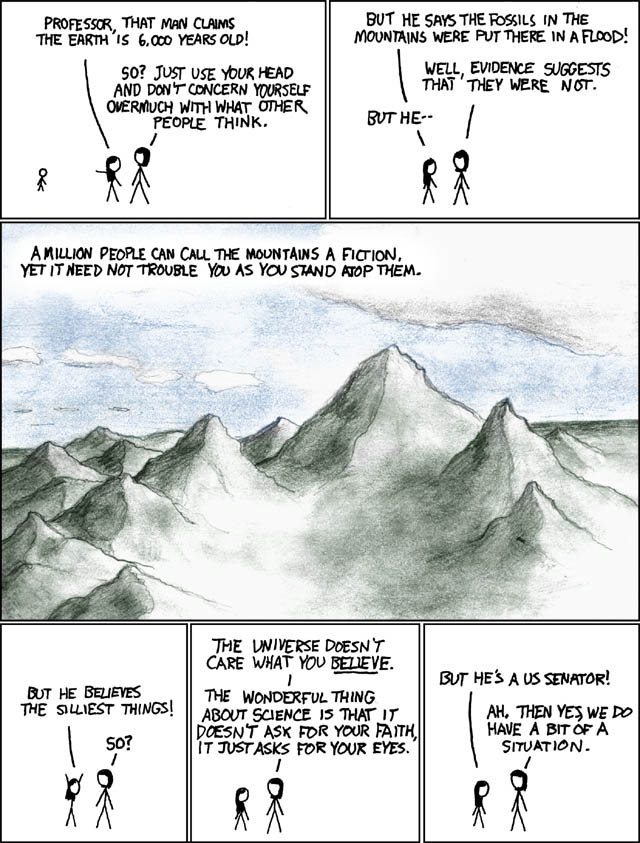Some time back in the’90’s I wrote a document explaining some things about black holes. To my amazement, people still read it, and they occasionally send me questions as a result. I’m happy to answer these when I can, and as long as I’m answering them anyway, I might as well post them here.
The latest is from Chris Warring:
My friend and I are having a debate over the question “If the Sun turned into a black hole, what would happen to the Earth’s orbit?”
I quoted from your article http://cosmology.berkeley.edu/Education/BHfaq.html “What if the Sun *did* become a black hole for some reason? The Earth and the other planets would not get sucked into the black hole; they would keep on orbiting in exactly the same paths they follow right now….a black hole’s gravity is no stronger than that of any other object of the same mass.”
My friend argued that since astroids impact the Sun then they would also impact the black hole. This would eventually increase the mass, increase the gravitational pull on the Earth, and place the Earth on a decaying orbit.
I have since read a little on Hawking Radiation, and that black holes evaporate. I now wonder if the black hole that was our Sun would evaporate, losing gravitational effects on the Earth, and the Earth would end up drifting away from where our Sun use to be.
Here’s my answer:
First, let me say that all of the effects you mention are very small. They would alter the Earth’s orbit a little bit over very long times. When I wrote what I did about the Earth’s orbit, I wasn’t considering such tiny effects. But they’re fun to think about, so here goes.
It is true that, if the mass of the Sun (or black hole, whichever is at the center of the Solar System) goes up, then the Earth’s orbit will be affected. Specifically, it would move to a smaller orbit. And of course the reverse is true if the mass goes down.
First, let’s talk about what’s happening right now, and then consider what happens if the Sun turned into a black hole. Right now, things do crash into the Sun from time to time, increasing the mass of the Sun. On the other hand, there’s constant evaporation from the Sun’s atmosphere (as well as energy escaping in the form of sunlight, which translates into a mass loss via E = mc2). I’m pretty sure that the net effect right
now is that the Sun is gradually losing mass. Taken in isolation, this mass change would cause the Earth to drift gradually into a larger orbit.
That phrase “Taken in isolation” is important. There are other things that affect Earth’s orbit much more than this tiny mass loss rate. The main one is gravitational tugs from other planets, especially Jupiter. I
guess it must be true that the gradual mass loss of the Sun gradually makes all of the planets drift further out, although the details might be complicated.
There’s also the fact that the Earth is being bombarded by meteors. Those presumably slow the Earth down in its orbit. Taken in isolation, that effect would make the Earth spiral in towards the Sun.
I’ve never tried to work out the size of any of these effects. A lot is known about the effects of other planets’ gravitation on our orbit (the buzzword for this being Milankovich cycles). The other effects are much smaller.
Now, what would happen if the Sun became a black hole? Things like meteors would still get absorbed from time to time, but much less often than they do now. That may go against intuition, because we think of black holes as really good at sucking things in, but in fact the black hole has the same gravitational pull as the Sun on objects far away, and it’s a much smaller target, so fewer things actually hit it. So the rate
of mass increase due to stuff falling in will be less than it is now. On the other hand, stuff won’t be evaporating nearly as fast as it does now. (There would be Hawking radiation, but that’s incredibly small, much less than the rate at which atoms are boiling off the Sun now.) So the net effect would certainly be that the black hole would gradually go up in mass, whereas the Sun gradually goes down. The net result would be that the Earth would gradually get closer to the black hole.
But again, the key word is “gradually”: these are really really tiny effects. I’d bet that they’d be too small to have any noticeable effect even over the age of the Universe.


